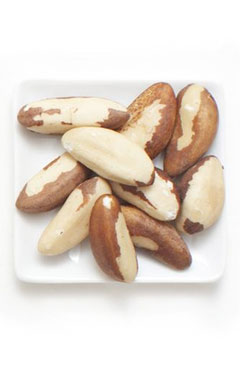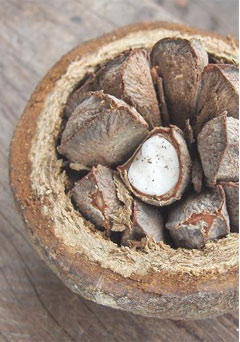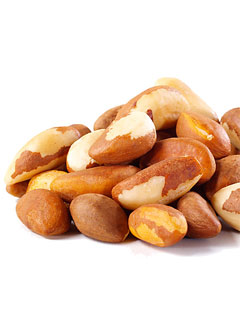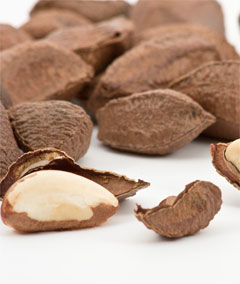|
|
Brazil Nuts: A Miracle Nut in your Diet

The Brazil nut is a South American tree in the family Lecythidaceae, and also
the name of the tree's commercially harvested edible seed. The Brazil nut family
is in the order Ericales, as are other well-known plants such as blueberries,
cranberries, sapote, gutta-percha, tea, gooseberries, phlox, and persimmons.
The Brazil nut tree is the only species in the monotypic genus Bertholletia. It
is native to the Guianas, Venezuela, Brazil, eastern Colombia, eastern Peru, and
eastern Bolivia. It occurs as scattered trees in large forests on the banks of
the Amazon River, Rio Negro, Tapaj�s, and the Orinoco. The genus is named after
the French chemist Claude Louis Berthollet.
The Brazil nut is a large tree, reaching 50 m (160 ft) tall and with a trunk 1
to 2 m (3.3 to 6.6 ft) in diameter, making it among the largest of trees in the
Amazon rainforests. It may live for 500 years or more, and according to some
authorities often reaches an age of 1,000 years. The stem is straight and
commonly without branches for well over half the tree's height, with a large
emergent crown of long branches above the surrounding canopy of other trees.
The bark is grayish and smooth. The leaves are dry-season deciduous, alternate,
simple, entire or crenate, oblong, 20�35 cm (7.9�14 in) long and 10�15 cm
(3.9�5.9 in) broad. The flowers are small, greenish-white, in panicles 5�10 cm
(2.0�3.9 in) long; each flower has a two-parted, deciduous calyx, six unequal
cream-colored petals, and numerous stamens united into a broad, hood-shaped
mass.
In Brazil, it is illegal to cut down a Brazil nut tree. As a result, they can be
found outside production areas, in the backyards of homes and near roads and
streets. The fruit containing nuts is very heavy and rigid, and it poses a
serious threat to vehicles and persons passing under the tree. At least one
person has died after being hit on the head by a falling fruit.
Brazil nut trees produce fruit almost exclusively in pristine forests, as
disturbed forests lack the large-body bees of the genera Bombus, Centris,
Epicharis, Eulaema, and Xylocopa which are the only ones capable of pollinating
the tree's flowers. Brazil nuts have been harvested from plantations, but
production is low and is currently not economically viable.
The Brazil nut tree's yellow flowers contain very sweet nectar and can only be
pollinated by an insect strong enough to lift the coiled hood on the flower and
with a tongue long enough to negotiate the complex coiled flower. For this
reason, the Brazil nut's reproduction depends on the presence of the orchid
Coryanthes vasquezii, which does not grow on the Brazil nut tree itself.
 The orchids produce a scent that attracts small male long-tongued orchid bees (Euglossa
spp.), as the male bees need that scent to attract females. The large female
long-tongued orchid bee pollinates the Brazil nut tree. Without the orchid, the
bees do not mate, and therefore the lack of bees means the fruit does not get
pollinated. The fruit takes 14 months to mature after pollination of the
flowers. The fruit itself is a large capsule 10�15 cm (3.9�5.9 in) in diameter,
resembling a coconut endocarp in size and weighing up to 2 kg (4.4 lb). It has a
hard, woody shell 8�12 mm (0.31�0.47 in) thick, which contains eight to 24
triangular seeds 4�5 cm (1.6�2.0 in) long (the "Brazil nuts") packed like the
segments of an orange. The orchids produce a scent that attracts small male long-tongued orchid bees (Euglossa
spp.), as the male bees need that scent to attract females. The large female
long-tongued orchid bee pollinates the Brazil nut tree. Without the orchid, the
bees do not mate, and therefore the lack of bees means the fruit does not get
pollinated. The fruit takes 14 months to mature after pollination of the
flowers. The fruit itself is a large capsule 10�15 cm (3.9�5.9 in) in diameter,
resembling a coconut endocarp in size and weighing up to 2 kg (4.4 lb). It has a
hard, woody shell 8�12 mm (0.31�0.47 in) thick, which contains eight to 24
triangular seeds 4�5 cm (1.6�2.0 in) long (the "Brazil nuts") packed like the
segments of an orange.
The capsule contains a small hole at one end, which enables large rodents like
the agouti to gnaw it open. They then eat some of the nuts inside while burying
others for later use; some of these are able to germinate into new Brazil nut
trees. Most of the seeds are "planted" by the agoutis in shady places, and the
young saplings may have to wait years, in a state of dormancy, for a tree to
fall and sunlight to reach it, when it starts growing again. Capuchin monkeys
have been reported to open Brazil nuts using a stone as an anvil.
Around 20,000 tons of Brazil nuts are harvested each year, of which Bolivia
accounts for about 50%, Brazil 40%, and Peru 10% (2000 estimates). In 1980,
annual production was around 40,000 tons per year from Brazil alone, and in
1970, Brazil harvested a reported 104,487 tons of nuts.
Brazil nuts are 18% protein, 13% carbohydrates, and 69% fat by weight, and 91%
of their calories come from fat. The fat breakdown is roughly 25% saturated, 41%
monounsaturated, and 34% polyunsaturated. Due to their high polyunsaturated fat
content, primarily omega-6 fatty acids, shelled Brazil nuts soon become rancid.
Nutritionally, Brazil nuts are a good source of some vitamins and minerals. A
cup (133 grams) of Brazil nuts contains the vitamins thiamin (0.8 mg�55% DV) and
vitamin E (7.6 mg�38% DV); minerals calcium (213 mg�21% DV), magnesium (500
mg�125% DV), phosphorus (946 mg�96% DV), copper (2.3 mg�116% DV), and manganese
(1.6 mg�81%).
Brazil nuts are perhaps the richest dietary source of selenium; 28 g (1 oz, 6�8
nuts) can contain as much as 544 �g. This is 10 times the adult U.S. Recommended
Dietary Allowances, more even than the Tolerable Upper Intake Level, although
the amount of selenium within batches of nuts varies greatly. Recent research
suggests that proper selenium intake is correlated with a reduced risk of both
breast cancer and prostate cancer. This has led some health commentators and
nutritionists to recommend the consumption of Brazil nuts as a protective
measure. However, these findings are inconclusive. Other investigations into the
effects of selenium on prostate cancer have also been inconclusive.
Brazil nuts have one of the highest concentrations of phytic acid at 2 to 6% of
dry weight. Phytic acid can prevent absorption of some nutrients, mainly iron,
but is also a subject of research and possibly confers health benefits. Despite
the possible health benefits of the nut, the European Union has imposed strict
regulations on the import from Brazil of Brazil nuts in their shells, as the
shells have been found to contain high levels of aflatoxins, which can lead to
liver cancer.
 Brazil nuts contain small amounts of radium. Although the amount of radium, a
radioactive element, is very small, about 1�7 pCi/g (40�260 Bq/kg), and most of
it is not retained by the body, this is 1,000 times higher than in other foods.
According to Oak Ridge Associated Universities, this is not because of elevated
levels of radium in the soil, but due to "the very extensive root system of the
tree." Brazil nuts contain small amounts of radium. Although the amount of radium, a
radioactive element, is very small, about 1�7 pCi/g (40�260 Bq/kg), and most of
it is not retained by the body, this is 1,000 times higher than in other foods.
According to Oak Ridge Associated Universities, this is not because of elevated
levels of radium in the soil, but due to "the very extensive root system of the
tree."
As well as its food use, Brazil nut oil is also used as a lubricant in clocks,
for making artists' paints, and in the cosmetics industry. Engravings in Brazil
nut shells were supposedly used as decorative jewelery by the indigenous tribes
in Bolivia, although no examples still exist. Because of its hardness, Brazil
nut shell has often been pulverized and used as an abrasive to polish softer
materials such as metals and even ceramics (in the same way as jeweler's rouge
is used). A high luster could be acquired by a final application of carnauba
wax, only produced in north-eastern Brazil.
The lumber from Brazil nut trees (not to be confused with Brazilwood) is of
excellent quality, but logging the trees is prohibited by law in all three
producing countries (Brazil, Bolivia and Peru). Illegal extraction of timber and
land clearances present a continuing threat.
Brazil nuts are large seeds that grow in South American virgin rainforests. The
crescent shaped seeds are enclosed in a dark brown, hard shell. The high fat,
high calorie nuts are much loved because of their rich, creamy flavor. They have
one of the highest contents of selenium amongst all nuts. They also contain
iron, copper, phosphorous, potassium, zinc and magnesium. A 1 ounce serving of
the nuts contains almost 200 calories. Below are some of the nutrients found in
these nuts and their role in the body.
Selenium
The remarkably high selenium content in the nuts gives them a potent antioxidant
property. Brazil nuts are one of the richest sources of selenium. This mineral
works with proteins to produce antioxidant enzymes. These help to prevent
cellular damage by free radicals. Selenium enhances the efficacy of the immune
system. It helps to reduce the risk of heart disease and prostrate cancer. It
also slows down the aging process and enables the thyroid gland to function
properly. However, too much selenium can upset the stomach, cause irritability,
fatigue, and loss of hair and nails.
Magnesium
A 1 ounce serving of magnesium provides about 65 mg of magnesium. Brazil nuts
have one of the highest amounts of magnesium amongst plant foods. This vital
mineral enhances the release of energy from foods to support nerve and muscular
functions. Magnesium supports the absorption of calcium in the body. It plays a
vital role in the formation of healthy teeth and bones. The risk of osteoporosis
can be reduced significantly by adequate intake of magnesium in the diet.
Magnesium supports a healthy heart. It helps to maintain healthy levels of blood
pressure, normalizes the heart rhythm and assists blood to clot properly in the
heart. This reduces the risk of stroke and heart disease. The mineral also
enables steady recovery in the event of a stroke. It plays a vital role n the
formation of new cells and helps to relax stiff and strained muscles.
Protein
 The nuts contain the complete range of proteins. This supplies all the
essential amino acids necessary for optimal growth and development. Brazil nuts
can serve as an ideal source of protein in a vegetarian diet. The nuts contain the complete range of proteins. This supplies all the
essential amino acids necessary for optimal growth and development. Brazil nuts
can serve as an ideal source of protein in a vegetarian diet.
Fats
Most nuts have a good combination of healthy fats. Brazil nuts contain Omega-3
fatty acids. These fats help to lower bad cholesterol levels in the blood.
However, the nuts have a higher content of saturated fats than other nuts. As
such, it is important that you consume them in moderation. Excessive intake
leads to high cholesterol levels. This increases the risk of heart-related
health complications.
Fiber
The nuts have a high content of fiber. Once consumed, they make you feel
full. This helps to regulate food intake. When eaten in moderation and combined
with other healthy foods, the nuts can enable proper weight control. Adequate
fiber in the diet contributes to optimal intestinal functions. This allows one
to pass stool regularly and with ease.
Video
Dated 22 November 2013
|
|
|
|
|









